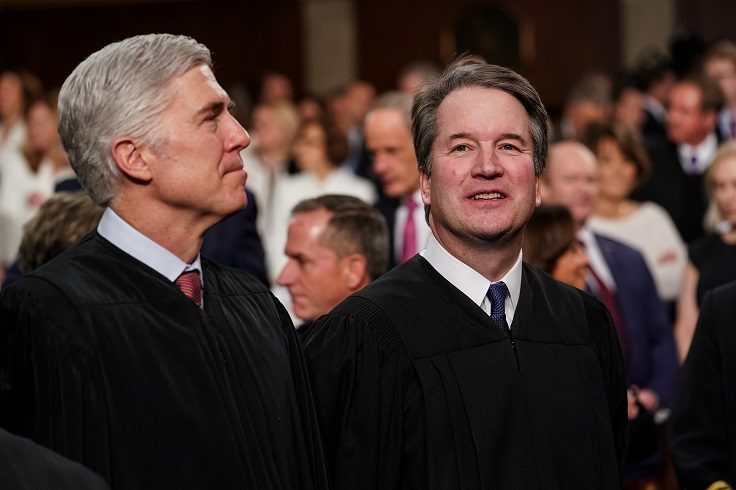With tensions high as the Senate Judiciary Committee prepared to vote on advancing Brett Kavanaugh's confirmation, senators packed into an anteroom—and turmoil ensued.
In their new book Justice on Trial, Mollie Hemingway, a senior editor at the Federalist, and Carrie Severino, chief counsel at the Judicial Crisis Network, offer an account of the process to confirm Brett Kavanaugh to the highest court.
On the day the committee vote was set, Sen. Chris Coons (D., Del.) tried to convince Arizona senator Jeff Flake to ask for a supplemental investigation into the sexual assault allegations against Kavanaugh. Meanwhile, other senators and staffers packed around them.
"In the epic, hours-long fight outside the meeting room, fistfights nearly broke out. One senator told another that he wanted to wring his neck. A staffer who was bringing lunch to her hungry boss found herself in the middle of the scrum, with Ted Cruz inadvertently standing on her foot and Sheldon Whitehouse spraying her with saliva as he debated a colleague," write Hemingway and Severino.
Aside from detailing the confirmation battle, the authors frame the fight over Kavanaugh in a broader context of conservative disappointments on the High Court, an unwillingness to give in to an organized left-wing attack machine, and a decades-long effort to challenge the hegemony of progressive jurisprudence.
Indeed, conservatives had suffered repeated disappointments as Republican presidents appointed judges who turned to the left. From Dwight D. Eisenhower to George W. Bush, "Republicans had filled nineteen Supreme Court seats, compared with eight for Democrats. Yet the reign of liberal activism on the Supreme Court had encountered few challenges."
Throughout the latter half of the 20th century, the Court was dominated by progressive jurisprudence, upsetting conservatives, whose "criticism was focused on the anti-democratic means by which the Court sought to reshape American society."
"The proper constitutional means to achieve any societal or legal change is legislation passed by elected representatives, not the fiat of unelected judges," conservatives argued. "Progressives disagreed."
Richard Nixon and Gerald Ford placed several justices on the Court, of which only one—William Rehnquist—can be described as "consistently a constitutionalist," according to Hemingway and Severino. George H.W. Bush's pick, David Souter, proved to be a liberal justice.
The sharp divide between progressive and conservative jurisprudence, and the lasting supremacy of the former, which the authors highlight, was evident as recently as 2015. Two of Ronald Reagan's appointments, Antonin Scalia and Anthony Kennedy, stood on opposite ends of Obergefell v. Hodges, the 5-4 decision legalizing gay marriage.
Kennedy wrote the opinion of the Court, which articulated the view that the Constitution "promises liberty to all within its reach, a liberty that includes certain specific rights that allow persons, within a lawful realm, to define and express their identity."
Scalia delivered a biting rebuke of Kennedy's reasoning, while also emphasizing the Court's anti-democratic assertion of power with the ruling.
"This is a naked judicial claim to legislative—indeed, super-legislative—power; a claim fundamentally at odds with our system of government. Except as limited by a constitutional prohibition agreed to by the People, the States are free to adopt whatever laws they like, even those that offend the esteemed Justices’ 'reasoned judgment.' A system of government that makes the People subordinate to a committee of nine unelected lawyers does not deserve to be called a democracy," Scalia wrote.
By the time of President Donald Trump's election, the Court stood narrowly divided and conservative judicial activists were ready to shape the Court despite the vicious opposition expected from the left. As Trump prepared to appoint a replacement for the swing-vote Kennedy, these activists were determined to not let the appointee suffer the same fate as Robert Bork.
Whereas Reagan had rejected offers by Clint Eastwood and Charlton Heston to appear in ads to counter anti-Bork activists, conservatives in 2018 were ready and "had learned the techniques pioneered by the left and had invented a few of their own."
On the day Kavanaugh was nominated, the Judicial Crisis Network had a $12 million war chest to spend on his behalf. Meanwhile, conservative activists from the Tea Party Patriots, Susan B. Anthony List, and Tea Party Patriots incorporated Kavanaugh's confirmation in their grassroots, door-to-door organizing.
Thus, conservatives were not caught off guard when, on the night of his nomination, protesters amassed at the Supreme Court, a few holding up pre-made signs reading #StopKethledge or #StopHardiman (other potential Supreme Court contenders).
"These lapses confirmed what everyone already knew—to the left, it didn't matter whom Trump nominated," write Hemingway and Severino.
Justice on Trial is primarily a narrative of an ugly confirmation fight, but within that narrative is a larger story about conservatives overcoming decades of letdowns to reshape the Court. And, as the authors note, those politicians who showed conservative voters they would not back down and stood with Kavanaugh were even rewarded with a bump in approval among Republicans—despite all the turmoil.
